 Web Front-end
Web Front-end JS Tutorial
JS Tutorial The bubbling mechanism of click events and its impact on web page interaction
The bubbling mechanism of click events and its impact on web page interaction
The role of click event bubbling and its impact on web page interaction
In web development, events are the key to interaction and responding to user operations. Among them, event bubbling is a common event mechanism that allows events in a nested element hierarchy to be responded to by multiple elements at the same time. This article will explain in detail the role of click event bubbling, its impact on web page interaction, and provide some specific code examples.
1. The concept of click event bubbling
Click event bubbling (Click Event Bubbling) refers to when an element is clicked, not only the element will trigger the corresponding event , the event is also propagated (bubbled) to its ancestor elements, up to the document root element (the HTML element).
In the DOM (Document Object Model) hierarchy, each element has an event handler that handles specific events. When a user clicks a button on a web page, the button itself first fires a click event, which then bubbles up and fires click events for each parent element, all the way to the document root element.
2. The role of click event bubbling
- Simplifying event processing
The biggest role of click event bubbling is to simplify event processing. When we need to bind the same event handler to multiple elements, we only need to bind the event once to the ancestor element to handle the events of all elements at the same time. This not only reduces the amount of code, but also facilitates unified management and maintenance.
- Dynamicly adding elements
Click event bubbling also makes dynamically adding elements more convenient. When elements are added dynamically via JavaScript, the newly added elements automatically inherit the event handlers of the ancestor elements, eliminating the need to bind separate events to each new element.
3. The impact of click event bubbling on web page interaction
- Event delegation
By using click event bubbling, we can implement events Delegate, that is, bind the event handler to the ancestor element, and then perform the corresponding operation by determining the element that triggered the event. This approach is more efficient when processing large numbers of elements, while reducing memory consumption and the amount of code required for event binding.
For example, the following code displays a list whose background color can be changed by clicking on the li element:
HTML code:
<ul id="list"> <li>选项1</li> <li>选项2</li> <li>选项3</li> <li>选项4</li> </ul>
JavaScript code:
document.getElementById("list").addEventListener("click", function(event) {
if (event.target.tagName === "LI") {
event.target.style.backgroundColor = "yellow";
}
});In this example, we bind the handler of the click event to the parent element ul of the list, and then change the background color by determining whether the element that triggered the event is a li element. In this way, no matter how many li elements are added, only one event binding needs to be modified, which improves the maintainability and performance of the code.
- Prevent event bubbling
Sometimes, we want to prevent events from bubbling to prevent events from continuing to propagate to upper elements. This can be achieved using the event.stopPropagation() method.
The following code shows the nested structure of a button and the parent container. Clicking the button will pop up a prompt box and prevent the event from bubbling up:
HTML code:
<div id="container"> <button id="btn">点击按钮</button> </div>
JavaScript code:
document.getElementById("container").addEventListener("click", function() {
alert("父容器被单击");
});
document.getElementById("btn").addEventListener("click", function(event) {
alert("按钮被单击");
event.stopPropagation();
});In this example, clicking the button will first trigger the click event of the button, and then prevent the event from continuing to propagate to the upper element, so the click event of the parent container will not be triggered.
To sum up, click event bubbling plays an important role in web page interaction. Through event bubbling, we can simplify event processing and improve code maintainability and performance. At the same time, techniques such as event delegation and preventing event bubbling can achieve more flexible and efficient web page interaction effects. I hope the explanations and examples in this article can help readers better understand and apply the click event bubbling mechanism.
The above is the detailed content of The bubbling mechanism of click events and its impact on web page interaction. For more information, please follow other related articles on the PHP Chinese website!
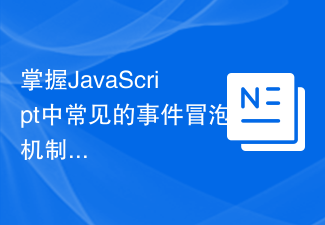 掌握JavaScript中常见的事件冒泡机制Feb 19, 2024 pm 04:43 PM
掌握JavaScript中常见的事件冒泡机制Feb 19, 2024 pm 04:43 PMJavaScript中常见的冒泡事件:掌握常用事件的冒泡特性,需要具体代码示例引言:在JavaScript中,事件冒泡是指事件会从嵌套层次最深的元素开始向外层元素传播,直到传播到最外层的父级元素。了解并掌握常见的冒泡事件,可以帮助我们更好地处理用户交互和事件处理。本文将介绍一些常见的冒泡事件,并提供具体的代码示例来帮助读者更好地理解。一、点击事件(click
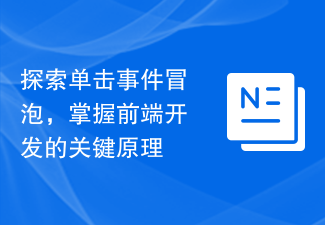 探索单击事件冒泡,掌握前端开发的关键原理Jan 13, 2024 am 10:56 AM
探索单击事件冒泡,掌握前端开发的关键原理Jan 13, 2024 am 10:56 AM学习单击事件冒泡,掌握前端开发中的关键概念,需要具体代码示例前端开发是当今互联网时代中的一个重要领域,而事件冒泡是前端开发中的一个关键概念之一。理解和掌握事件冒泡对于编写高效的前端代码至关重要。本文将介绍什么是事件冒泡,以及如何在前端开发中使用事件冒泡的概念。一、什么是事件冒泡事件冒泡是指当一个元素上的事件被触发时,会先从最内层的元素开始,然后逐级向父级元素
 哪些JS事件不会向上传播?Feb 19, 2024 am 08:17 AM
哪些JS事件不会向上传播?Feb 19, 2024 am 08:17 AMJS事件中哪些不会冒泡?在JavaScript中,事件冒泡是指当一个元素触发了某个事件时,该事件会逐级向上冒泡到更高层的元素,直到冒泡到文档根节点。然后,事件处理程序会按照冒泡的顺序依次执行。然而,并不是所有的事件都会冒泡。有些事件在触发后只会执行目标元素上的事件处理程序,而不会冒泡到更高层的元素上。下面是一些常见的不会冒泡的事件:focus和blur事件:
 通过利用单击事件冒泡,如何增强网页交互体验Jan 13, 2024 pm 02:23 PM
通过利用单击事件冒泡,如何增强网页交互体验Jan 13, 2024 pm 02:23 PM如何利用单击事件冒泡实现更灵活的网页交互体验引言:在前端开发中,我们经常会遇到需要在网页的一部分元素上添加点击事件的情况。然而,如果页面中的元素很多,为每个元素都添加点击事件将变得非常繁琐和低效。单击事件冒泡就可以帮助我们解决这个问题,通过将点击事件添加到公共父元素上,实现更灵活的网页交互体验。一、单击事件冒泡的原理单击事件冒泡是指当一个元素上的点击事件被触
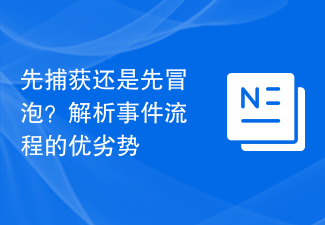 先捕获还是先冒泡?解析事件流程的优劣势Feb 21, 2024 pm 02:36 PM
先捕获还是先冒泡?解析事件流程的优劣势Feb 21, 2024 pm 02:36 PM先捕获还是先冒泡?解析事件流程的优劣势事件流程是Web开发中一个重要的概念,它描述了事件从发生到被处理的过程。在处理事件时,有两种主要的流程模型:先捕获后冒泡和先冒泡后捕获。这两种模型在不同的场景下各有优劣势,需要根据实际情况选择合适的模型。先捕获后冒泡是指在事件冒泡阶段前,先执行事件捕获阶段。事件捕获阶段从事件目标的根节点开始,逐级向下传递,直到到达目标元
 学习事件冒泡,轻松实现复杂的交互效果Jan 13, 2024 am 08:01 AM
学习事件冒泡,轻松实现复杂的交互效果Jan 13, 2024 am 08:01 AM掌握事件冒泡,轻松实现复杂交互效果,需要具体代码示例事件冒泡(EventBubbling)是前端开发中一个重要的概念,它指的是当一个元素上的事件被触发后,该事件会自动向父级元素传播,直到传播到文档根元素。掌握了事件冒泡的原理和应用,我们可以轻松实现复杂的交互效果,提升用户体验。下面将通过具体的代码示例,来帮助读者更好地理解和应用事件冒泡。代码示例一:点击展
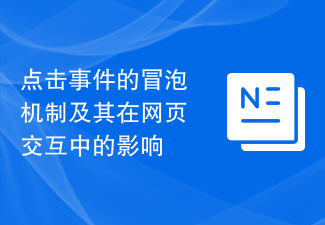 点击事件的冒泡机制及其在网页交互中的影响Jan 13, 2024 pm 02:34 PM
点击事件的冒泡机制及其在网页交互中的影响Jan 13, 2024 pm 02:34 PM单击事件冒泡的作用及其对网页交互的影响在网页开发中,事件是实现交互和响应用户操作的关键。其中,事件冒泡是一种常见的事件机制,它允许一个嵌套的元素层次结构中的事件同时被多个元素响应。本文将详细解释单击事件冒泡的作用,并说明它对网页交互的影响,同时提供一些具体的代码示例。一、单击事件冒泡的概念单击事件冒泡(ClickEventBubbling)指的是当一个元
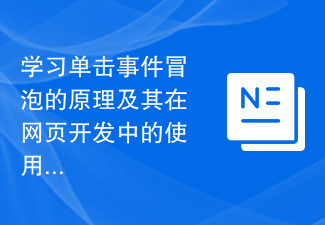 学习单击事件冒泡的原理及其在网页开发中的使用方式Jan 13, 2024 pm 12:47 PM
学习单击事件冒泡的原理及其在网页开发中的使用方式Jan 13, 2024 pm 12:47 PM了解单击事件冒泡的原理及其在网页开发中的应用在网页开发中,经常会涉及到与用户的交互操作。其中,事件是实现这种交互效果的重要机制之一。在这些事件中,单击事件(clickevent)是应用最广泛的一种。学习了解单击事件冒泡的原理及其在网页开发中的应用,能够更好地掌握事件机制,实现更加丰富的用户交互体验。一、单击事件冒泡的原理当一个元素上发生了某个事件,如果这个


Hot AI Tools

Undresser.AI Undress
AI-powered app for creating realistic nude photos

AI Clothes Remover
Online AI tool for removing clothes from photos.

Undress AI Tool
Undress images for free

Clothoff.io
AI clothes remover

AI Hentai Generator
Generate AI Hentai for free.

Hot Article

Hot Tools

mPDF
mPDF is a PHP library that can generate PDF files from UTF-8 encoded HTML. The original author, Ian Back, wrote mPDF to output PDF files "on the fly" from his website and handle different languages. It is slower than original scripts like HTML2FPDF and produces larger files when using Unicode fonts, but supports CSS styles etc. and has a lot of enhancements. Supports almost all languages, including RTL (Arabic and Hebrew) and CJK (Chinese, Japanese and Korean). Supports nested block-level elements (such as P, DIV),

Notepad++7.3.1
Easy-to-use and free code editor

SAP NetWeaver Server Adapter for Eclipse
Integrate Eclipse with SAP NetWeaver application server.

VSCode Windows 64-bit Download
A free and powerful IDE editor launched by Microsoft

DVWA
Damn Vulnerable Web App (DVWA) is a PHP/MySQL web application that is very vulnerable. Its main goals are to be an aid for security professionals to test their skills and tools in a legal environment, to help web developers better understand the process of securing web applications, and to help teachers/students teach/learn in a classroom environment Web application security. The goal of DVWA is to practice some of the most common web vulnerabilities through a simple and straightforward interface, with varying degrees of difficulty. Please note that this software





